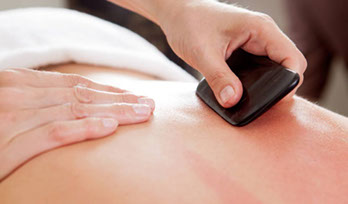
Gua Sha
Raising sha removes blood stagnation considered pathogenic in traditional Chinese Medicine. Modern research shows the transitory therapeutic petechiae produce an anti inflammatory and immune protective effect that persists for days following a single Gua sha treatment accounting for the immediate relief that patients feel from pain, stiffness, fever, chill, cough, wheeze, nausea and vomiting etc.
What is Gua Sha Using for?
Gua sha is most often used to relieve muscle and joint pain. Conditions of the muscles and bones are known as musculoskeletal disorders, such as neck and shoulder stiffness and headaches, but it can be used in other places as well.
Practitioners claim that gua sha can also benefit the immune system and reduce inflammation. Sometimes, gua sha is used to treat a cold, fever, or problems with the lungs.
Microtrauma may also help with fibrosis, which is a buildup of too much connective tissue when the body heals.
Gua sha may reduce inflammation, so it’s often used to treat ailments that cause chronic pain, such as arthritis and fibromyalgia, as well as those that trigger muscle and joint pain.
Gua Sha is frequently used to treat The color of the “sha” will vary from pink to blackish purple. Like cupping, the marks can last up to a few days, but generally fade quickly.
The name gua sha — comes from the Chinese word for scraping. It may also be called skin scraping, spooning, or coining.
Gua sha is the practice of using a tool to apply pressure and scrape the skin hard and deep, to relieve pain and tension. The practice involves scraping a flat, rounded tool, usually made of jade, over the skin. Gua sha is defined as instrument-assisted unidirectional press-stroking of a lubricated area of the body surface to intentionally create transitory therapeutic petechiae called ‘sha’ representing extravasation of blood in the subcutis. This action causes light bruising, which often appears as purple or red spots known as sha. Small injuries to the body, such as the bruises caused by gua sha, are sometimes known as microtrauma. These create a response in the body that may help to break up scar tissue.





